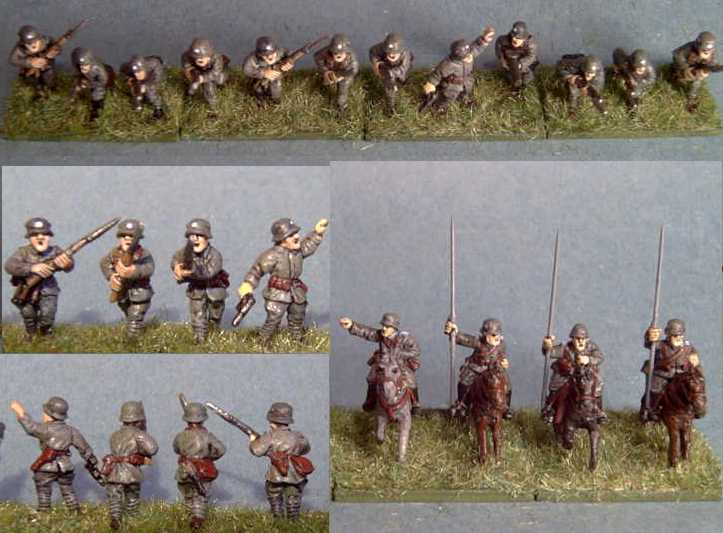
Figures used for Nationalists
All codes relate to Peter Pig packs. I mixed horses from different packs to add variety.
German Freikorps in the Baltic
Peter Pig have just made a pack of Freikorps infantry, 16–149. They are firmly based on the men in the Osprey Freikorps books, so unlike the rest of their infantry ranges they do not have packs and gas masks but do have the pistols and knives more typical of the Freikorps. This makes them perfect for the Russian Civil War, as well as the street fighting in Germany. The four poses of the new pack are shown as close up as my camera will allow in the bottom left of this picture:

In the unit above I have extended the three rifle poses in the specifically Freikorps packs with two poses from pack 16–77 by converting a few details, such as shaving down epaulettes and altering cartridge boxes (the remaining pose from 16–77, with a very Russian style rolled up greatcoat, gets a head-swap and becomes a White Russian, so is not wasted). I have also added a Lewis gunner to this unit, while others get banners or other details (this allows me to have only two of each rifleman pose in a unit of 12).
The MGs and artillery crew are basically the standard PP late WWI packs in helmet. I have added some variety to them by taking early war packs, shaving off some of the blouse details not present in late war uniforms and using the "heads" range to replace the pickelhaubes.
My cavalry are a mix of men from 16–30 "German cavalry" with replaced heads and some WWII men, quite heavily converted.
I intend to use them primarily as German Freikorps in the Baltic (including the Baltic Landwehr and Bermondt-Avalov's forces) and as Poznanian Poles, so precise adherence to uniform regulations was unlikely. The white spot on the helmet represents a Freikorps insignia, such as skull and bones or swastika, but also a Polish eagle. I might also press them into service as Prince Lieven's forces with Yudenich, although in this case they really should have Russian style epaulettes.
Poles
The official Polish uniform didnt really get introduced for lower ranks until after the Soviet war, so Poles should be in ex-Russian, German, Austrian or French uniforms, or sometimes British cast-offs. In my case I shall use my Freikorps figures (above) as Poznanians, perhaps filling in the last company in the battalions with reserve units mostly in civvies (from the Estonians, below).
That takes care of the bulk of the men, since the riflemen, artillery and MG bases are fine as they are, but the higher command elements and cavalry need more work. For the senior command elements the German officer figures are fine, but they need Polish flags. I hope to add some officers in the official uniform (khaki, with square cap and decorated collars) to make them a bit more Polish, and a few French "advisers" in horizon blue for even more colour.
For the divisional cavalry of the infantry I shall paint a small unit from pack 16–4 "German uhlans", complete with old fashioned cap.
In the separate cavalry brigades the situation is more complicated – unlike the infantry, where at least the whole of a division were from one source and tried to dress in standard uniforms (not that they necessarily succeeded) – the regiments of cavalry brigades all came from different sources and wore the uniforms that reflected this. In order to avoid having to duplicate painting effort, I shall take some regiments from my White Guard cavalry (in Russian uniforms with coloured caps) and some Drozdovski cavalry (straight British uniforms) and mix these with units wearing ex-German Uhlan uniforms (16–4) and ex-French uniforms (16–114 and 16–116). If Peter Pig release Austrian cavalry, then perhaps some of these might enter the mix too.
Note: the "Poles" in the PP range technically represent the Poles in French service on the Western front but will suffice for the "Blue Army" (the Rogatywka cap was quite often an Adrian helmet or a round cap, and the equipment on the figure is excessive).
Estonian Nationalists
The infantry were painted to represent men in assorted uniforms and civilian dress, trying to get them as mixed as possible. These men will also be used to represent Latvians, the hastily raised reinforcement companies of Poles, Red Guards and perhaps even as Greens.
16–58 Russian infantry in greatcoat
16–41 Russian gun crew
16–49 Russian HMGs
16–51 Red guard
16–53 Red guard HMGs
16–78 Russian tatty partisans
16–81 Czech Legion infantry [firing poses]
16–77 Russian infantry in German helmets
16–96 Russian infantry in greatcoat and furry hat [stationary poses]
Where I painted men wearing pieces of old uniform I mixed ex-Russian with ex-German, to reflect the likely sources of such pieces. Should I get round to painting an elite unit, such as a railway landing company, I shall probably put them largely in British uniforms.
Estonian cavalry were a real pain because I wanted to avoid the Budenovkas of the Red Cavalry and the too-uniform look of the Whites. In the end I converted a whole bunch of figures with head swaps, including some from the 16–18 French Dragoons pack, so that now they look rather like civilians in cap (albeit with guns and on horses).
